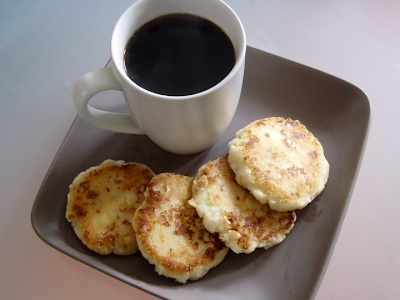Background
Finding the dishes for this meal was very easy. I sent an email to a Colombian friend from high school and Javier promptly got back to me with several options and a reminder that Colombia also has coffee. Javier's list of recommendations was arepas, pan de bono, and bunuelos.
Bunuelos are deep fried fritters that looks a lot like doughnut holes. According to Wikipedia they most likely originated from Sephardic Jews or Arabs and are popular through out the Mediterranean and former Spanish colonies. We decided against these because we are reluctant to deep fry on a gas stove.
Pan de bono is a bread made of corn flour, cassava, cheese, and eggs. It is sometimes bagel-shaped and other times in little puff balls. Preparation is not difficult, but we decided to give the arepas a try because we like farmer's cheese and our cookbook, Secrets of Colombian Cooking, had many different varieties of arepas.
We made two kinds of arepas. The first was arepas de choclo and the second was arepas de queso. We will get to why we cooked two arepas in the discussion.
Arepas de Choclo
- 1 cup plus 2 tbsp cut corn
- 8 oz white farmer's cheese
- 1½ tbsp melado
- 1 tsp sugar
- 1/8 tsp salt
- oil or butter

- Put the corn in a food processor and chop for one minute.
- Grate a little less than 4 oz of the cheese.
- Mix corn, sugar, salt, melado and cheese.
- Cover a small non-stick skillet with oil or butter and place over medium heat.
- Place ½ cup of the mixture on the hot pan, flattening it out a little bit.
- Cook for 4 minutes.
- Flip it on a plate and cook the opposite side for 4 minutes.
- Serve with butter on the side and slices of the remaining cheese.
Melado
- ¼ lb grated panela
- ¾ cup water
- 1 cinnamon stick
- Combine panela, cinnamon, and water.
- Simmer mixture until the panela dissolves completely.
- Boil for 5 minutes and allow the syrup to thicken.
Arepas de Queso
- 1/3 cup instant masa
- 1/3 cup warm water
- 2 tsp soft butter
- ½ tsp salt
- ¼ lb grated farmer's cheese
- oil or butter for cooking
- Mix cornmeal, water, butter, and salt for 30 seconds by hand until it has a pasty consistency. Let it stand for 5 minutes.
- Knead this mixture with your hands for a minute until it feels doughy.
- Add the grated cheese to the dough and knead again.
- Divide the dough into 4 balls.
- Shape the balls into little patties about ½ in thick.
- Melt a knob of butter into a frying pan over medium heat.
- Cook the Arepas on both sides for 2 minutes until they are a golden color.
- Serve with melado.
Results and Discussion
We had an extra hour this morning because of the time shift and we really needed it. The first mistake was trying to make the melado and not adding the water. This gives a very bad result and should be avoided if at all possible.
When we made the Arepas de Choclo they fell apart and stuck to the pan when we flipped them. I think the problem had a few possible causes. The one I suspect most was our failure to add enough oil. The recipe just called for a light coating but given the low amount of butter the author called on the arepas de queso I think she is stingy with the oil. Another problem might have been increased water content because we used frozen corn. I could have also failed to get the heat on the pan right. Whatever the cause they fell apart when we tried to flip them and the results looked like badly botched omelet. We snacked on them while making the arepas de queso and they were nothing really special.
The arepas de queso were very successful. I was initially worried about the ratio of cheese to masa but it worked very nicely. The outsides were crisp and cheese was well melted. The salt called for in the recipe was unneeded because the saltiness of the cheese. Dipping it in the melado cuts the salt and adds a very nice subtle sweetness. The author recommends making these as appetizers for parties and I would agree with her. I would just use much more oil or butter than she recommends.

No comments:
Post a Comment